Fujifilm FinePix F50fd
-
-
Written by Gordon Laing
Fujifilm FinePix F50fd design and controls
Fujifilm’s FinePix F50fd is a smart, metal-bodied compact with a brushed front surface and cross-hatched logo. We’ve pictured it below on the left, alongside the equally classy Panasonic Lumix DMC-FX33, a particularly compact model with 8.1 Megapixels. Measuring 93x59x23mm, the F50fd’s main body shares virtually the same width and thickness as the FX33, but is 7mm taller, making it appear much larger.
Following an increasing trend with compacts these days, there’s no horizontal ridge on the front surface to push your middle finger against. There’s also no dedicated section on the rear to rest your thumb. Instead with the F50fd you’ll need to close your grip until your middle finger pushes against a small ridge running vertically down the side, and position your thumb either on the mode dial on the back or between it and the screen. Ergonomically it’s not an ideal arrangement, but you can still hold the camera relatively easily with one hand.
Like most metal-bodied compacts from premium manufacturers, the build quality is very good with no creaks or poor joins to worry about. The F50fd feels solid and confident and while its 173g weight with battery makes it heavier than many rival compacts, it’s not so heavy to put a strain on a shirt pocket. For greater protection against the elements or indeed up to 40m of water above your head, there’s also the optional WP-FXF50 underwater housing.
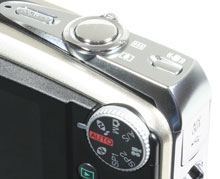 |
The F50fd’s top surface is home to the power button, shutter release surrounded by a zoom rocker and a button to activate the Dual Image Stabilisation mode. There’s also an infra red port for wirelessly transmitting images between other suitably-equipped Fujifilm cameras.
The bulk of the controls are round the back of the camera and to the right of the screen. In the top right corner is the mode dial with six positions and some lettering which may not be immediately obvious unless you’ve used a FinePix model before. The N mode stands for Natural Light and as its name suggests, takes a photo with higher sensitivity without a flash. There’s also an N mode with a flash symbol though which takes two photos: one with natural light and a second with the flash just to make sure – although remember to warn your subjects they’re posing for two photos.
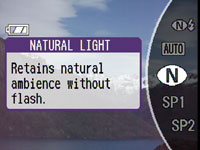 |
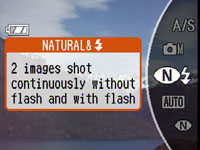 |
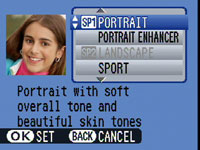 |
SP1 and SP2 allow you to select one of 14 scene presets through the on-screen menu system, each accompanied by a description and example photo.
The A/S mode stands for Aperture and Shutter Priority. Both occupy the same position on the mode dial, so you need to select the desired mode from a menu, after which the F50fd allows you to make adjustments as desired. In Shutter Priority you can select shutter speeds from 1 second to 1/1000 (with the camera also supporting 8 seconds to 1/2000 in other modes), while in Aperture Priority with the lens zoomed-out, there’s ten apertures to choose from.
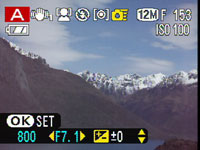 |
These modes may require a few button presses to access, but it’s still good to have this degree of control on a compact. Finally, M does stand for manual, but it’s actually more like Program mode on other cameras, still operating automatically but with more options for adjustment.
Below the mode dial you’ll find the usual four-way joypad with a button in the middle to fire-up the menu or confirm options. Around this are four further buttons for Playback, Display mode, Face Detection and Fujifilm’s F-Mode menu – see below for more details.
Fujifilm FinePix F50fd Screen and menus
Fujifilm splits its options between the F-Mode menu and the main menu system. The former is where you’ll get to change the ISO sensitivity, image quality, FinePix Colour mode, and curiously also the camera’s power management options.
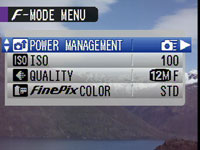 |
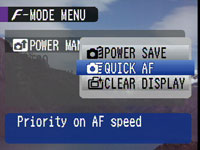 |
In the latter you’re able to choose a self-explanatory Quick AF option or the Clear Display mode which brightens the screen and uses a smoother refresh rate. Both modes will drain your battery quicker, so if you want to eek-out the longest life, choose the Power Save option which reduces the screen refresh and also dims the display after ten seconds; note selecting Intelligent Face Detection will cancel the Power Save mode.
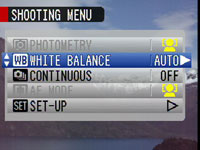 |
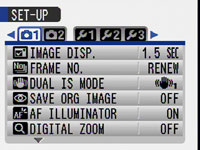 |
Pressing the Menu button presents further options to adjust the metering mode, white balance, continuous shooting and AF mode, with a final option to enter the five Setup menus. Fujifilm’s approach to menus and options is a little odd compared to rival cameras though. It’s great to have a button offering instant access to common settings, but in the case of Fujifilm’s F-Mode menu, you wonder why White Balance and perhaps burst shooting aren’t included there, when Power Saving is.
As for the screen itself, the F50fd employs a 2.7in model with 230k pixels which looks best when set to the Clear Display mode. Directly compared against other compacts with 2.5in 230k monitors, the live image on-screen could look slightly coarse at times, especially on smooth curves or diagonal lines.
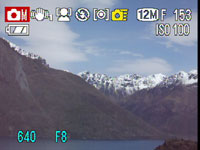 |
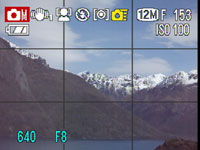 |
Pressing the DISP button cycles between three views during recording modes: one with shooting information, one that shows the image alone, and a third which overlays a grid for help with alignment or applying the rule of thirds. Sadly for a camera which prides itself on having more manual controls than average, there’s no histogram either when shooting or during playback.
Fujifilm FinePix F50fd Battery and connectivity
The Fujifilm FinePix F50fd is powered by a 1000mAh NP-50 Lithium Ion battery pack and is supplied with a mains recharger. Fujifilm estimates 230 frames under CIPA conditions, although we managed around half this amount using the Power Save mode and image stabilisation on most shots.
Behind a flap on the right side of the camera is a combined USB and TV output port, and below the camera you’ll find a combined battery and memory card compartment. While this door may be blocked when the F50fd’s mounted on a tripod, we’re pleased to report the camera has a dual-media card slot which can handle either Fujifilm’s favoured xD format or the more common and affordable SD format.




